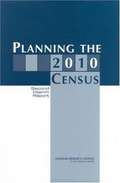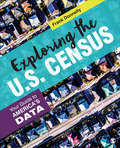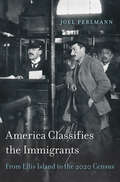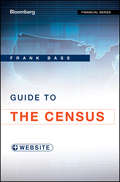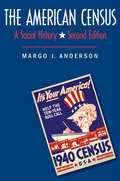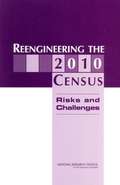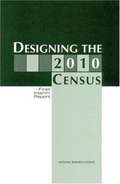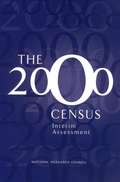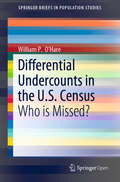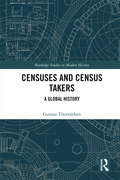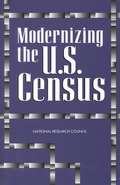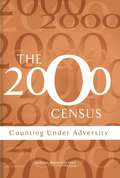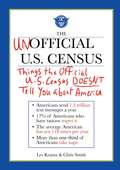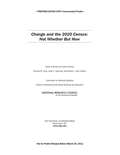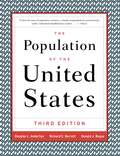Special Collections
Census 2020
Description: Have you ever wondered why a bus is located far from you? Which area gets schools, or new roads? Through data collected from the the US Census Bureau, of course. Subscribe to this collection to learn more about the Census. #general
- Table View
- List View
PLANNING THE 2010 CENSUS
by Panel on Research on Future Census MethodsA report on Planning the 2010 Census
Exploring the U.S. Census
by Francis DonnellyThe United States census provides researchers, students, and the public with some of the richest and broadest information available about the American people. Exploring the U.S. Census by Frank Donnelly gives social science students and researchers alike the tools to understand, extract, process, and analyze data from the decennial census, the American Community Survey, and other data collected by the U.S. Census Bureau. More than just a data collection exercise performed every ten years, the census is a series of datasets updated on an ongoing basis. With all that data comes opportunities and challenges: opportunities to teach students the value of census data for studying communities and answering research questions, and the challenges of navigating and comprehending such a massive data source and transforming it into usable information that students and researchers can analyze with basic skills and software. Just as important as showing what the census can tell social researchers is showing how to ask good questions of census data.
Exploring the U.S. Census provides a thorough background on the data collection methods, structures, and potential pitfalls of the census for unfamiliar researchers, collecting information previously available only in widely disparate sources into one handy guide. Hands-on, applied exercises at the end of the chapters help readers dive into the data.
The first chapter of the book places the census into context, discussing the history and the role of the census in society as well as in the larger universe of government, open, and big data. The book then moves onto the essentials of the data structure including the variety of sources and searching mechanisms, geography from nation down to zip code, and the fundamental subject categories (social, economic, and geographic) that are used for summarizing data in all of the various datasets.
The next section delves into the individual datasets, discussing the purpose and structure of each, with separate chapters devoted to the decennial census, ACS, Population Estimates Program, and business datasets. A final chapter for this section pulls everything together, with a focus on writing and presenting your research on the data. The final section covers advanced topics and applications including mapping, geographic information systems, creating new variables and measures from census data, historical census data, and microdata.
Along the way, the author shows how best to analyze census data with open-source software and tools, such as QGIS geographic information system, LibreOffice® Calc, and the DB Browser for SQLite®. Readers can freely evaluate the data on their own computers, in keeping with the free and open data provided by the Census Bureau. By placing the census in the context of the open data movement, this text makes the history and practice of the census relevant so readers can understand what a crucial resource the United States census is for research and knowledge.
America Classifies the Immigrants
by Joel PerlmannWhen more than twenty million immigrants arrived in the United States between 1880 and 1920, the government attempted to classify them according to prevailing ideas about race and nationality. But this proved hard to do. Ideas about racial or national difference were slippery, contested, and yet consequential—were “Hebrews” a “race,” a “religion,” or a “people”? As Joel Perlmann shows, a self-appointed pair of officials created the government’s 1897 List of Races and Peoples, which shaped exclusionary immigration laws, the wording of the U.S. Census, and federal studies that informed social policy. Its categories served to maintain old divisions and establish new ones.
Across the five decades ending in the 1920s, American immigration policy built increasingly upon the belief that some groups of immigrants were desirable, others not. Perlmann traces how the debates over this policy institutionalized race distinctions—between whites and nonwhites, but also among whites—in immigration laws that lasted four decades.
Despite a gradual shift among social scientists from “race” to “ethnic group” after the 1920s, the diffusion of this key concept among government officials and the public remained limited until the end of the 1960s. Taking up dramatic changes to racial and ethnic classification since then, America Classifies the Immigrants concentrates on three crucial reforms to the American Census: the introduction of Hispanic origin and ancestry (1980), the recognition of mixed racial origins (2000), and a rethinking of the connections between race and ethnic group (proposed for 2020).
Guide to the Census
by Frank BassHow to parse, analyze, and incorporate census dataThis handy resource offers a reference guide for anyone interested in tailoring specific Census data to their needs. It includes computer coding (SAS v9.x) software for extracting targeted data from thousands of Census files, as well as primers on using online tools and mapping software for analyzing data.
The book offers thorough coverage of all aspects of census data including its historical significance, suggestions for parsing housing, occupation, transportation, economic, health, and other data from the census, and much more.
Offers an guide to analyzing Census data that can have an impact on financial markets as well as housing and economic data boding ill or well for the future of the economyIt includes computer coding (SAS v9.x) scripts for extracting specific data from Census files
Offers guidance on using thousands of variables from Census results released every year and American Community Survey data now released every year
The only one-stop guide to analyzing and using annual and decennial Census data
Bass offers a practical guide for leveraging information compiled by the Census to further research as well as business interests.
The American Census
by Margo AndersonThis book, published on the eve of the bicentennial of the American census, is the first social history of this remarkably important institution, from its origins in 1790 to the present. Margo Anderson argues that the census has always been an influential policymaking tool, used not only to determine the number of representatives apportioned to each state but also to allocate tax dollars to states, and, in the past, to define groups-such as slaves and immigrants-who were to be excluded from the American polity.
Reengineering the 2010 Census
by Panel on Research on Future Census MethodsAt the request of the U.S. Census Bureau, the National Research Council's Committee on National Statistics established the Panel on Research on Future Census Methods to review the early planning process for the 2010 census.
This new report documents the panel's strong support for the major aims of the Census Bureau's emerging plan for 2010. At the same time, it notes the considerable challenges that must be overcome if the bureau's innovations are to be successful. The panel agrees with the Census Bureau that implementation of the American Community Survey and, with it, the separation of the long form from the census process are excellent concepts.
Moreover, it concurs that the critically important Master Address File and TIGER geographic systems are in dire need of comprehensive updating and that new technologies have the potential to improve the accuracy of the count.
The report identifies the risks and rewards of these and other components of the Census Bureau's plan. The report emphasizes the need for the bureau to link its research and evaluation efforts much more closely to operational planning and the importance of funding for a comprehensive and rigorous testing program before 2010.
DESIGNING THE 2010 CENSUS
by Panel on Research on Future Census MethodsA report on Designing the 2010 Census
THE 2000 CENSUS
by Panel to Review the 2000 CensusThis volume contains the full text of two reports: one is an interim review of major census operations, which also assesses the U.S. Census bureau's recommendation in March 2001 regarding statistical adjustment of census data for redistricting. It does not address the decision on adjustment for non-redistricting purposes.
The second report consists of a letter sent to William Barron, acting director of the Census Bureau. It reviews the new set of evaluations prepared by the Census Bureau in support of its October decision. The two reports are packaged together to provide a unified discussion of statistical adjustment and other aspects of the 2000 census that the authoring panel has considered to date.
Differential Undercounts in the U.S. Census
by William O’HareThis book describes the differences in US census coverage, also referred to as “differential undercount”, by showing which groups have the highest net undercounts and which groups have the greatest undercount differentials, and discusses why such undercounts occur.
In addition to focusing on measuring census coverage for several demographic characteristics, including age, gender, race, Hispanic origin status, and tenure, it also considers several of the main hard-to-count populations, such as immigrants, the homeless, the LBGT community, children in foster care, and the disabled.
However, given the dearth of accurate undercount data for these groups, they are covered less comprehensively than those demographic groups for which there is reliable undercount data from the Census Bureau. This book is of interest to demographers, statisticians, survey methodologists, and all those interested in census coverage.
Censuses and Census Takers
by Gunnar ThorvaldsenThis book analyses the international development of the census by comparing the history of census taking on all continents and in many countries. The timeframe is wide, from male censuses in the Bible to current censuses covering the whole population. There is a focus on the efforts and destinies of census takers and the development of methods used to collect information into the census questionnaires. The book highlights international cooperation in census taking, as well as how computerized access to census data facilitates genealogical studies and statistical research on both historical and contemporary societies. It deals with such questions as "Why did the French and British gentry block efforts at census taking in the 18th century?"; "What role did German censuses play during Holocaust?"; Why were the Soviet census directors executed as part of the Moscow processes?"; "Why did US states sue the Census Bureau in the 1970s?"; "How do wars and revolutions affect census taking?". The text ends by discussing whether the days of the population census as we know it are numbered, since countries exceedingly construct censuses by combining information from population registers rather than with questionnaires.
Modernizing the U.S. Census
by Barry Edmondston and Charles SchultzeThe U.S. census, conducted every 10 years since 1790, faces dramatic new challenges as the country begins its third century. Critics of the 1990 census cited problems of increasingly high costs, continued racial differences in counting the population, and declining public confidence.
This volume provides a major review of the traditional U.S. census. Starting from the most basic questions of how data are used and whether they are needed, the volume examines the data that future censuses should provide. It evaluates several radical proposals that have been made for changing the census, as well as other proposals for redesigning the year 2000 census.
The book also considers in detail the much-criticized long form, the role of race and ethnic data, and the need for and ways to obtain small-area data between censuses.
THE 2000 CENSUS
by Panel to Review the 2000 CensusThe decennial census was the federal government’s largest and most complex peacetime operation. This report of a panel of the National Research Council's Committee on National Statistics comprehensively reviews the conduct of the 2000 census and the quality of the resulting data. The panel's findings cover the planning process for 2000, which was marked by an atmosphere of intense controversy about the proposed role of statistical techniques in the census enumeration and possible adjustment for errors in counting the population.
The report addresses the success and problems of major innovations in census operations, the completeness of population coverage in 2000, and the quality of both the basic demographic data collected from all census respondents and the detailed socioeconomic data collected from the census long-form sample (about one-sixth of the population). The panel draws comparisons with the 1990 experience and recommends improvements in the planning process and design for 2010.
The 2000 Census: Counting Under Adversity will be an invaluable resource for users of the 2000 data and for policymakers and census planners. It provides a trove of information about the issues that have fueled debate about the census process and about the operations and quality of the nation's twenty-second decennial enumeration.
The Unofficial U.S. Census
by Les Krantz and Chris SmithOn April 1, 2011, the Official 2010 U.S. Census Report will be released. On that same day, The Unofficial U.S. Census will shed light (and a bit of laughter) on all the other facts that Americans are itching to know about our country and each other.
Les Krantz and Chris Smith have collected facts from a variety of sources, compiling a fascinating and insightful look into America-an up-to-date demographic profile that will include what the government forgot to ask us, such as who we sleep with, what we ingest, what we own, what we drive, when we have sex, what we tattoo on our bodies, and much more!
With clever photos and captions, the book includes fifty enlightening and fun chapters covering all aspects of American life, including sporting activities, sex, edibles, education, religious beliefs, family profiles, criminal activities, body piercing, dating, driving, and net worth.
The Unofficial U.S. Census is an engaging portrait of America, jammed with facts and fun-warts and all!
Change and the 2020 Census
by The National Academy of SciencesSponsored by the Census Bureau and charged to evaluate the 2010 U. S. census with an eye toward suggesting research and development for the 2020 census, the Panel to Review the 2010 Census uses this first interim report to suggest general priorities for 2020 research.
Although the Census Bureau has taken some useful organizational and administrative steps to prepare for 2020, the panel offers three core recommendations, and suggests the Census Bureau take and assertive, aggressive approach to 2020 planning rather than casting possibilities purely as hypothetical.
The first recommendation on research and development suggests four broad topic areas for research early in the decade. Second, the report suggest that the Bureau take an aggressive, assertive posture toward research in these priority areas. Third, it identifies the setting of bold goals as essential to underscoring the need for serious reengineering and building commitment to change.
The Population of the United States (3rd edition)
by Richard E. Barrett and Donald J. Bogue and Douglas L. AndertonThis third edition, written with two new coauthors, combines 1990 census data with information from the Current Population Survey, the National Health Interview Survey, and numerous other sources, even including demographic data not available in any other published source.
